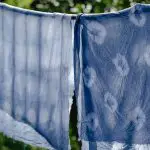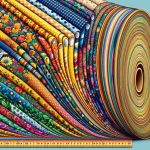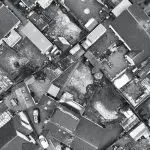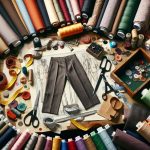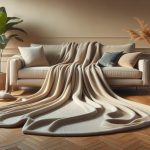Guess what – a yard of fabric isn't just a random measurement!
Have you ever wondered how long a yard of fabric really is and why it matters?
Let's unravel this fabric mystery together.
Table of Contents
Key Takeaways
- Fabric width impacts yardage needs and project planning.
- Understanding usable fabric size aids in efficient project execution.
- Visual comparisons of fabric widths help in choosing suitable materials.
- Consider pre-washing losses and cutting techniques for accurate yardage calculations.
Typical Fabric Widths
When it comes to sewing projects, knowing the typical widths of different fabrics is essential for proper planning and accurate material estimation. Different types of fabric come in specific widths that can impact your yardage requirements. For example, quilting cotton, broadcloth, and flannel usually range from 41 to 45 inches wide. If you're working with home décor fabrics, you'll often find widths of 54 or 60 inches, giving you more fabric to work with for larger projects. Apparel fabrics, on the other hand, commonly have a width of 60 inches, which is great for making clothing items without needing as much yardage.
Understanding these standard fabric widths is important because it helps you calculate how much fabric you need for your project accurately. Whether you're making a quilt, a pillowcase, or a dress, being aware of the typical fabric widths for different types of fabric will make sure that you purchase the right amount of material without running short.
What Is a Yard
Understanding the concept of a yard in fabric measurement is fundamental for any sewing project. A yard of fabric refers to a specific length, measuring 36 inches. This measurement is equivalent to 3 feet or approximately 91.44 centimeters.
When you buy fabric, it's important to remember that the length is fixed at 36 inches, while the width can vary depending on the type of fabric, typically ranging from 36 to 60 inches. Fabric is commonly sold in linear yards, so knowing the length of a yard is critical for accurate purchasing and project planning.
To make sure you get enough fabric for your project, consider both the length and width of a yard. Having a good grasp of what a yard means regarding fabric length will help you make informed decisions when shopping for materials and working on your sewing projects.
Cutting Fabric at the Store
Moving from knowing the length of a yard of fabric, let's look at the practical aspect of cutting fabric at the store. When you head to a fabric store to get your desired length, you might notice different techniques for cutting fabric. Some stores use rulers and scissors, while others opt for ripping the fabric. Ripped cuts can result in straighter edges, especially noticeable on woven fabrics. However, it's critical to highlight that ripping may not be suitable for all types of materials.
After cutting the fabric, it's common practice for stores to iron the fabric. This helps stabilize any frayed edges and ensures a neater finish. The way fabric is cut at the store can greatly impact the overall quality and handling of the fabric. Therefore, it's advisable to inquire about the store's cutting methods, especially if you have specific preferences or requirements. Understanding how the store cuts fabric can help you choose the best option for your project.
Usable Size of Cut Fabric
When working on a sewing project, it's important to think about the usable size of the fabric you've cut. Straightening those edges and accounting for possible losses due to pre-washing are key steps.
To guarantee you have enough fabric for your project, rounding up the amount needed can help compensate for any potential waste.
Fabric Cutting Techniques
When cutting fabric, always account for potential edge issues that may result in loss of usable fabric for your project. After making your initial cut, straightening the edges is important to determine the final usable fabric size.
Remember that pre-washing can lead to some loss due to fraying or shrinking. Ripping the fabric can result in straighter edges, especially for woven materials. To guarantee a neater finish, ironing the edges after cutting is a helpful technique.
It's wise to round up the amount of fabric needed to accommodate any potential losses from cutting and straightening edges. By being mindful of these fabric cutting techniques, you can maximize the usable fabric for your sewing projects.
Ideal Fabric Dimensions
To maximize the usable fabric for your sewing projects, ensuring the ideal dimensions after cutting is essential. When working with fabric, understanding the yards and width measurements is vital.
After straightening the cut edges, the usable fabric is what remains for your project. It's wise to round up the amount needed to compensate for any potential losses due to edge issues, ensuring you have an exact measurement.
Utilizing a conversion chart can help determine fractions of a yard in inches and centimeters for smaller fabric quantities. Visualizing these measurements using a ruler or tape measure will aid in accurate cutting and project planning.
Fabric Waste Reduction
After straightening the cut edges of fabric, maximizing the usable portion is essential for minimizing waste in sewing projects. When aiming to reduce fabric waste, consider the following:
- Use a Yardage Conversion Chart: Utilize this tool to accurately measure fabric, especially when cutting smaller quantities, to avoid overestimating and wasting material.
- Measure Fabric Precisely: Round up the amount needed to compensate for potential losses due to edge issues post pre-washing, ensuring an exact measurement and reducing waste.
- Reduce Waste Through Precision: Visualize measurements with a ruler or tape measure, iron frayed edges for stability, and cut with precision to minimize waste and achieve a neat finish in your sewing projects.
Round up or Down
For fabric planning, it's best to round up instead of down to guarantee you have enough material for your project. When it comes to rounding numbers in fabric calculations, always consider rounding up to the nearest whole number to avoid any shortages.
The general rule is that if the number is 5 or above, round up; if it's below 5, round down. This strategy confirms that you have a bit of extra fabric to account for any unforeseen issues like shrinkage or mistakes during cutting. Precision in rounding is key.
Rounding up allows for a buffer that can make a significant difference in the success of your project. It's better to have a bit more fabric than you need than to run short and risk not being able to complete your project as planned. So, remember to round up and be prepared for any surprises that may arise!
Knit, Woven, Nonwoven Fabric Differences
Knit fabrics are stretchy and made of interlocking loops.
Woven fabrics, on the other hand, are structured with threads woven together.
Nonwoven fabrics are bonded through various processes and are often used for disposable items.
Fabric Types Overview
Often overlooked but important to understanding the diversity of fabrics used in clothing and other products are the differences between knit, woven, and nonwoven fabrics. Here's a breakdown to help you grasp the distinctions:
- Knit Fabrics:
- Made by interlocking yarns.
- Known for their stretch and flexibility.
- Commonly found in activewear and casual clothing for comfort and ease of movement.
- Woven Fabrics:
- Created by weaving yarns at right angles.
- Result in a structured and non-stretchy textile.
- Popular choices for dressier garments and home decor due to their durability and tailored appearance.
- Nonwoven Fabrics:
- Produced by bonding fibers using various methods.
- Often used in disposable items like face masks.
Knit Vs. Woven
Understanding the difference between knit and woven fabrics is key to selecting the right material for your sewing projects.
Knit fabrics, like your favorite t-shirt, are made by interlocking loops of yarn, providing stretch and comfort.
On the other hand, woven fabrics, commonly found in dress shirts and denim, are produced by weaving yarn in an over-under pattern, resulting in a more structured and less stretchy material.
When it comes to fabric sizes, knit fabrics typically come in a standard width of 60 inches, while woven fabrics can vary from 45 to 60 inches wide.
Knowing these distinctions will help you choose the perfect fabric for your project and make the most out of your yards of material.
Nonwoven Characteristics
Nonwoven fabrics, unlike traditional knit and woven materials, are manufactured by bonding or interlocking fibers through various mechanical, chemical, or thermal processes. These fabrics offer unique characteristics due to their method of production:
- Nonwoven fabrics are made by entangling fibers through processes like needle punching, heat bonding, or chemical bonding.
- They lack a grain or stretch, providing stability and strength in applications where these properties are essential.
- Nonwoven fabrics are commonly used in industries such as healthcare, automotive, construction, and agriculture for their versatility and cost-effectiveness.
These characteristics make nonwoven fabrics ideal for products like wipes, medical gowns, and filters, where quick production and reliability are paramount.
Yard of Fabric Photo Comparisons
When comparing different fabric widths, a yard of 60-inch wide fabric visually appears larger than a yard of 45-inch wide fabric. This difference in width affects how the fabric drapes, its utility for various projects, and the overall look of the final product. To illustrate this visually, I've prepared a comparison table below showing how a yard of fabric looks in different widths.
| Fabric Width | Visual Representation |
|---|---|
| 45 inches |  |
| 60 inches |  |
| 90 inches |  |
Looking at the images in the table, you can see how the same yard of fabric can appear wider or narrower based on the fabric width. This visual aid helps in understanding the impact of fabric width on the overall appearance and functionality of your sewing projects. Remember, a yard of fabric is always 36 inches long, so the width is what truly varies in different fabrics.
Yardage Conversion Chart
To accurately convert yardage measurements for your sewing projects, refer to a yardage conversion chart. Understanding fabric dimensions, especially the fabric width, is essential for determining the amount of fabric needed.
Here are three key points to help you master yardage conversion:
- Fabric Width Variations: Common fabric widths range from 36 to 60 inches. The width of the fabric impacts how much yardage is required for a project. For example, a project that needs 2 yards of 60-inch wide fabric may require more yardage if using 36-inch wide fabric.
- Linear Yard Measurements: Fabric is typically sold in linear yards, which measure 36 inches in length. It's critical to take into account both the length and width of the fabric when calculating yardage for a project.
- Conversion Assistance: Yardage conversion charts can help you convert yards to feet, meters, and centimeters accurately. These charts simplify the process of translating fabric measurements into different units, aiding in precise project planning.
Frequently Asked Questions
Is a Yard of Fabric 3 Feet Long?
Yes, a yard of fabric is indeed 3 feet long. It's a standard measurement that equals 36 inches. Knowing this helps in accurately planning and purchasing fabric. It's essential information when dealing with fabric measurements.
What Does 2 Yards of Fabric Look Like?
Two yards of fabric appear as a piece measuring 72 inches in length and 36 inches in width when unfolded. This amount of fabric is great for larger projects, providing ample material for sewing or crafting endeavors.
How Much Is a Full Yard of Fabric?
A full yard of fabric measures 36 inches in length. It equals 3 feet, important info for accurate measurements. Fabric is typically sold in linear yards, width varies. Knowing this is key for buying fabric.
How Much Fabric Does a Yard Cover?
A yard of fabric covers an area based on its width in inches and a standard length of 1 yard. It's crucial to take into account the width when determining how much fabric a yard covers for sewing or crafting projects.
- Why Is Red Velvet Not Red? - April 25, 2024
- How Do You Describe Velvet Fabric? - April 25, 2024
- How Strong Is Velvet? - April 25, 2024


